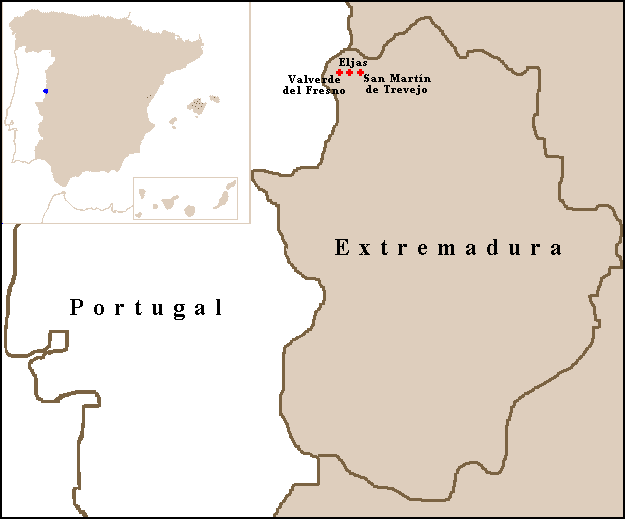
Asteburu luze honetan "Extremauran" izan naiz, ezkontza batean. Nire adiskide Sonia eta Fran ziren ezkontzekoak eta, Sestaon bizi diren arren, bion familiak hangoak direnez, hantxe ibili ginen asteburu osoan. Udaberriko garai honetan are lurralde zoragarriagoa begitandu zait hangoa. Baina nire ustekaberik handiena hizkuntzaren aldetik etorri da. Izatez, bi hizkuntza desberdin aurkitu ditut, bizi-bizirik biak. Bata, "extremeñu" izena hartuko lukeena, eta bestea "A Fala de Xálima" litzateke. Lehena, "Extremaurako" inguru zabal batean hitz egiten da, Caceresko probintziaren ipar mendebaldean, lehen mapan ikus daitekeenez. Astur-leoneraren dialektoa litzateke eta, zenbait herritan, gazteek barra-barra erabiltzen dute. Ezkontidearen anaiak esan zidanez, esaterako,
hotz naiz "tengu friu" litzateke; edo
ilea busti, berriz,
esmullecer el pelu.
Hori nahikoa izan ez balitz, hona anaiak berak esan zidala bazela gailegoaren dialektoa hitz egiten zuten hiru herri, Gatako mendikatearen magalean. Eta halaxe da,
hemen eta
hemen egiazta daitekeen moduan. Azpian dagoen mapak adierazten du herrion kokapena.
Jamaika ikusteko jaioak gara!

----------------------
At the West-Southwestern corner of the Spanish State there is a region called "Extremadura". I've been there these four last days of our beloved May 1st bank holiday. some friends of mine were going to marry and I had to do the preaching at the ceremony. Which I did. But that's not the reason I'm writing now here.
I've discovered a very beautiful country, so green these days. And most of all, I've discovered two languages I knew almost nothing about. One of them is the so-called "Extremeñu", kind of a dialect of the better known "Bable", which is spoken from the coastal region of Asturies, far north of Extremadura, till there. I thought it had been lost far ago in these parts. But no; it seems to be quite strong yet, since young people still use it. The first map shows where this language is used.
The second language is even weirder than the previous one. In fact, it seems to be a dialect of Galician, the language spoken in the Northwest corner of the Iberian Peninsula. The second map gives its situation.
Interesting, isn't it?
 Sarean gora eta behera nenbilela, "Otro Dios es posible" webgunea aurkitu nuen. Biziki gomendatzen dizuet. "Un Tal Jesús"-en egileen beste maisulan bat, alafede. Bertan Jesukristo berriz Lurrera etorriko balitz egingo lizkioketen elkarrizketa batzuk (100) azaltzen dira. Gaika sailkaturik daude eta hainbat pertsonek, sinestedunek eta bestelako kontutan fededun direnek ere bere buruari galdetzen dizkioten hainbat kontu entzun eta irakur daitezke. Gaur, Homofobiaren Kontrako Nazioarteko Egunean, honako hau gomendatzen dizuet.
Sarean gora eta behera nenbilela, "Otro Dios es posible" webgunea aurkitu nuen. Biziki gomendatzen dizuet. "Un Tal Jesús"-en egileen beste maisulan bat, alafede. Bertan Jesukristo berriz Lurrera etorriko balitz egingo lizkioketen elkarrizketa batzuk (100) azaltzen dira. Gaika sailkaturik daude eta hainbat pertsonek, sinestedunek eta bestelako kontutan fededun direnek ere bere buruari galdetzen dizkioten hainbat kontu entzun eta irakur daitezke. Gaur, Homofobiaren Kontrako Nazioarteko Egunean, honako hau gomendatzen dizuet.

